
Build a More Effective Brand Architecture
Neglecting to maintain the brand architecture can have the following consequences:
- Inconsistent branding across product lines, services, and marketing communications.
- Employee confusion regarding product lines, services, and brand structure.
- Difficulties in launching new products or services or integrating acquired brands.
- Poor customer experience in navigating the website or understanding the offerings.
- Inability to differentiate from competitors.
- Weak brand equity and a lack of brand loyalty.
Our Advice
Critical Insight
Brand architecture is the way a company organizes and manages its portfolio of brands to achieve strategic goals. It encompasses the relationships between brands, from sub-brands to endorsed brands to independent brands, and how they interact with each other and with the master brand. With a clear brand architecture, businesses can optimize their portfolio, enhance their competitive position, and achieve sustainable growth and success in the long run.
Impact and Result
Establishing and upholding a well-defined brand architecture is critical to achieve:
- Easy recognition and visibility
- Consistent branding
- Operational efficiency
- Customer loyalty
- Ability to easily adapt to changes
- Competitive differentiation
- Distinctive brand image
- Business success
Build a More Effective Brand Architecture Research & Tools
Besides the small introduction, subscribers and consulting clients within this management domain have access to:
1. Build a More Effective Brand Architecture Storyboard – Develop a brand architecture that supports your business goals, clarifies your brand portfolio, and enhances your overall brand equity.
We recommend a two-step approach that involves defining or reimagining the brand architecture. This means choosing the right strategy by analyzing the current brand portfolio, identifying the core brand elements, and determining and developing the structure that fits with the brand and business goals. A well-thought-out brand architecture also facilitates the integration of new brands and new product launches.
- Build a More Effective Brand Architecture Storyboard
2. Brand Architecture Strategy Template – The brand architecture template is a tool for creating a coherent brand identity.
Create a brand identity that helps you launch new products and services, prepare for acquisitions, and modify your brand strategy. Allocate resources more effectively and identify new opportunities for growth. A brand architecture can provide insights into how different brands fit together and contribute to the overall brand strategy.
- Brand Architecture Strategy Template
Infographic
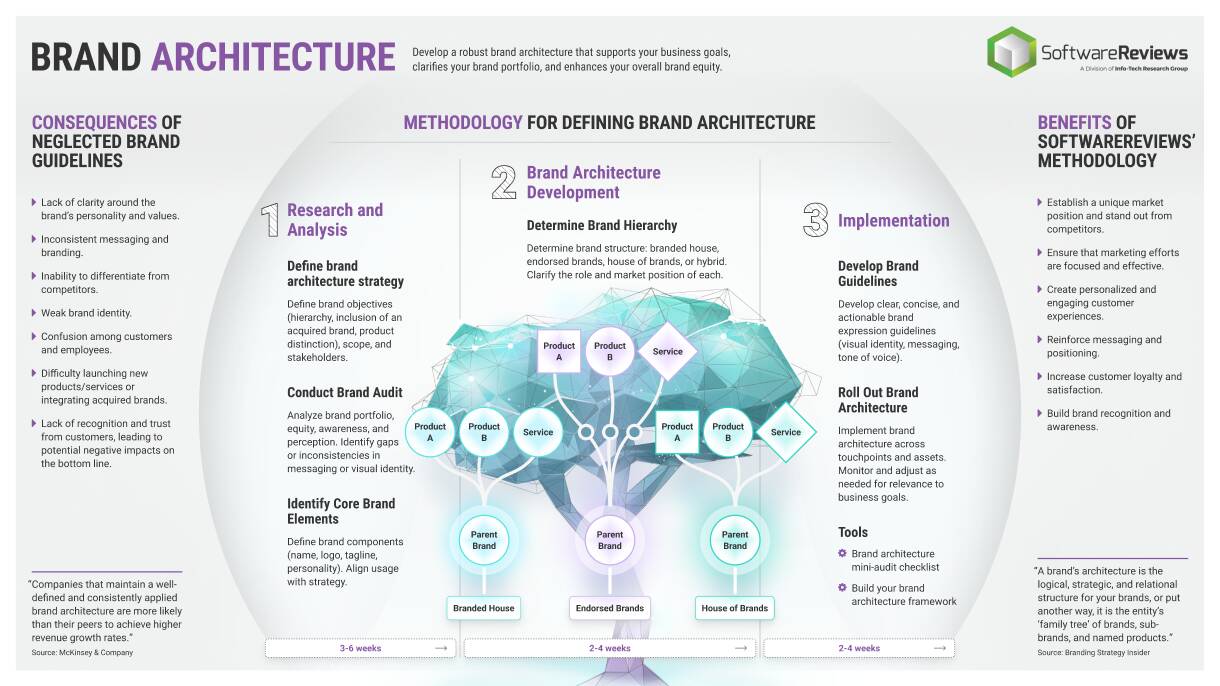
Workshop: Build a More Effective Brand Architecture
Workshops offer an easy way to accelerate your project. If you are unable to do the project yourself, and a Guided Implementation isn't enough, we offer low-cost delivery of our project workshops. We take you through every phase of your project and ensure that you have a roadmap in place to complete your project successfully.
1 Brand Mind Mapping
The Purpose
The brand mind mapping workshop is an exercise that helps with visualizing brand architecture and improving coherence and effectiveness in brand portfolio management.
Key Benefits Achieved
This exercise can help businesses:
Allocate their resources more effectively.
Identify new opportunities for growth.
Gain a competitive advantage in their market.
Activities
1.1 Brand Mind Mapping
Outputs
Visual representation of the brand architecture and its various components
Further reading
Build a More Effective Brand Architecture
Strategically optimize your portfolio to increase brand recognition and value.
Analyst perspective
Brand Architecture

Nathalie Vezina
Marketing Research Director
SoftwareReviews Advisory
This blueprint highlights common brand issues faced by companies, such as inconsistencies in branding and sub-branding due to absent or inadequate planning and documentation or non-compliance with the brand architecture. It emphasizes the importance of aligning or modifying the company's brand strategy with the existing architecture to create a consistent brand when launching new products, services, or divisions or preparing for acquisitions.
Changing the brand architecture can be challenging, as it often requires significant resources, time, and effort. Additionally, there may be resistance from stakeholders who have become attached to the existing brand architecture and may not see the value in making changes. However, it's important for companies to address suboptimal brand architecture to ensure consistency and clarity in brand messaging and support business growth and success.
This blueprint guides brand leaders on building and updating their brand architecture for optimal clarity, consistency, adaptability, and efficiency.
Executive summary
| Your Challenge | Common Obstacles | SoftwareReviews’ Approach |
A company's brand architecture can help brand managers build a stronger brand that supports
the company's goals and increases brand value. Failing to maintain the brand architecture can have the following consequences:
|
Establishing and maintaining a clear brand architecture can pose significant issues for brand leaders. Despite these obstacles, defining the brand architecture can yield substantial benefits for businesses. Common constraints are:
|
With focused and effective efforts and guidance, brand leaders can define or reimagine their brand architecture. Developing and maintaining a clear and consistent brand architecture involves:
|
"[B]rand architecture is like a blueprint for a house...the foundation that holds all the pieces together, making sure everything fits and works seamlessly."
Source: Verge Marketing
The basics of brand architecture
The significance of brand hierarchy organization
Brand architecture is the hierarchical organization and its interrelationships. This includes shaping the brand strategy and structuring the company's product and service portfolio.
A well-designed brand architecture helps buyers navigate a company's product offerings and creates a strong brand image and loyalty.
A company's brand architecture typically includes three levels:
- Master or parent brand
- Sub-brands
- Endorsed brands
Choosing the right architecture depends on business strategy, products and services, and target audience. It should be reviewed periodically as the brand evolves, new products and services are launched, or new brands are acquired.
"A brand architecture is the logical, strategic, and relational structure for your brands, or put another way, it is the entity's 'family tree' of brands, sub-brands, and named products."
Source: Branding Strategy Insider
Enhancing a company's brand hierarchy for better business outcomes
Maximize brand strategy with a well-defined and managed brand architecture.
Align brand architecture with business goals
A well-defined brand architecture aligned with business objectives contributes to building brand recognition, facilitating brand extension, and streamlining brand portfolio management. In addition, it improves marketing effectiveness and customer experience.
With a clear and consistent brand architecture, companies can strengthen their brand equity, increase awareness and loyalty, and grow in their competitive environment.
Effectively engage with the desired buyers
A clear and consistent brand architecture enables companies to align their brand identity and value proposition with the needs and preferences of their target audience, resulting in increased customer loyalty and satisfaction.
Establishing a unique market position and reinforcing brand messaging and positioning allows companies to create a more personalized and engaging customer experience, driving business growth.
Maintain a competitive edge
An effective brand architecture allows companies to differentiate themselves from their competitors by establishing their unique position in the market. It also provides a structured framework for introducing new products or services under the same brand, leveraging the existing one.
By aligning their brand architecture with their business objectives, companies can achieve sustainable growth and outperform their competitors in the marketplace.
"A well-defined brand architecture provides clarity and consistency in how a brand is perceived by its audience. It helps to create a logical framework that aligns with a brand's overall vision and objectives."
Source: LinkedIn
Pitfalls of neglecting brand guidelines
Identifying the negative effects on business and brand value.
Deficient brand architecture can manifest in various ways.
Here are some common symptoms:
- Lack of clarity around the brand's personality and values
- Inconsistent messaging and branding
- Inability to differentiate from competitors
- Weak brand identity
- Confusion among customers and employees
- Difficulty launching new products/services or integrating acquired brands
- Lack of recognition and trust from consumers, leading to potential negative impacts on the bottom line
Brand architecture helps to ensure that your company's brands are aligned with your business goals and objectives, and that they work together to create a cohesive and consistent brand image.
The most common obstacles in developing and maintaining a clear brand architecture
Establishing and maintaining a clear brand architecture requires the commitment of the entire organization and a collaborative effort.
Lack of stakeholder buy-in > Resistance to change
Siloed teams > Inconsistent execution
Limited resources > Lack of education and communication
Types of brand architectures
Different approaches to structuring brand hierarchy
Brand architecture is a framework that encompasses three distinct levels, each comprising a different type of branding strategy.
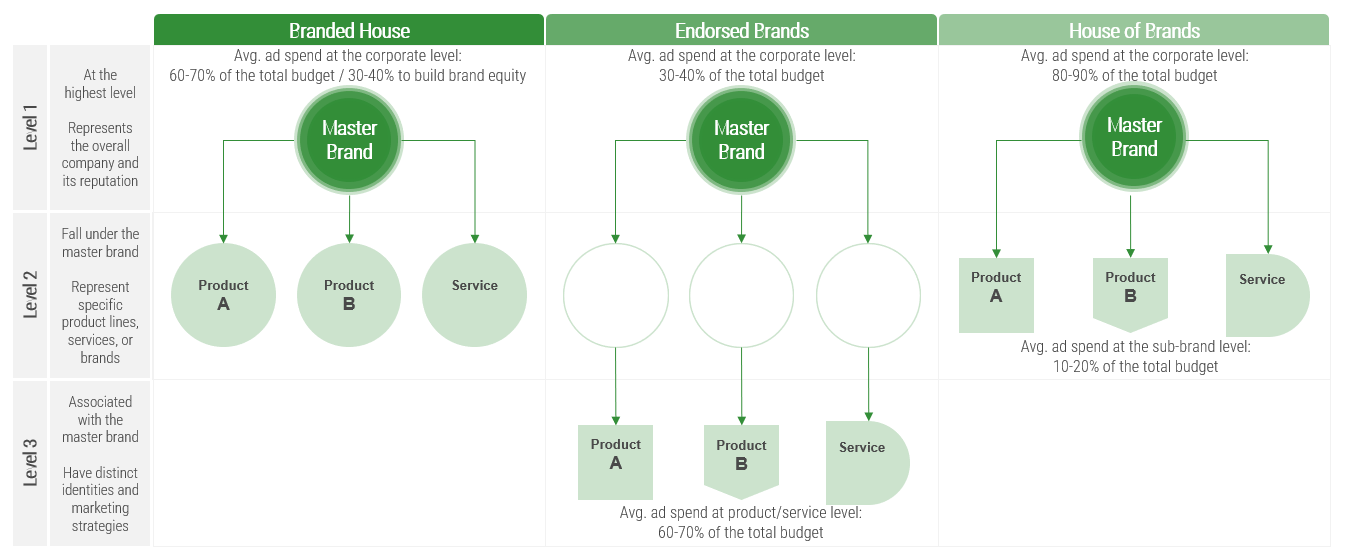
Examples of types of brand architectures
Well-known brands with different brand and sub-brands structures
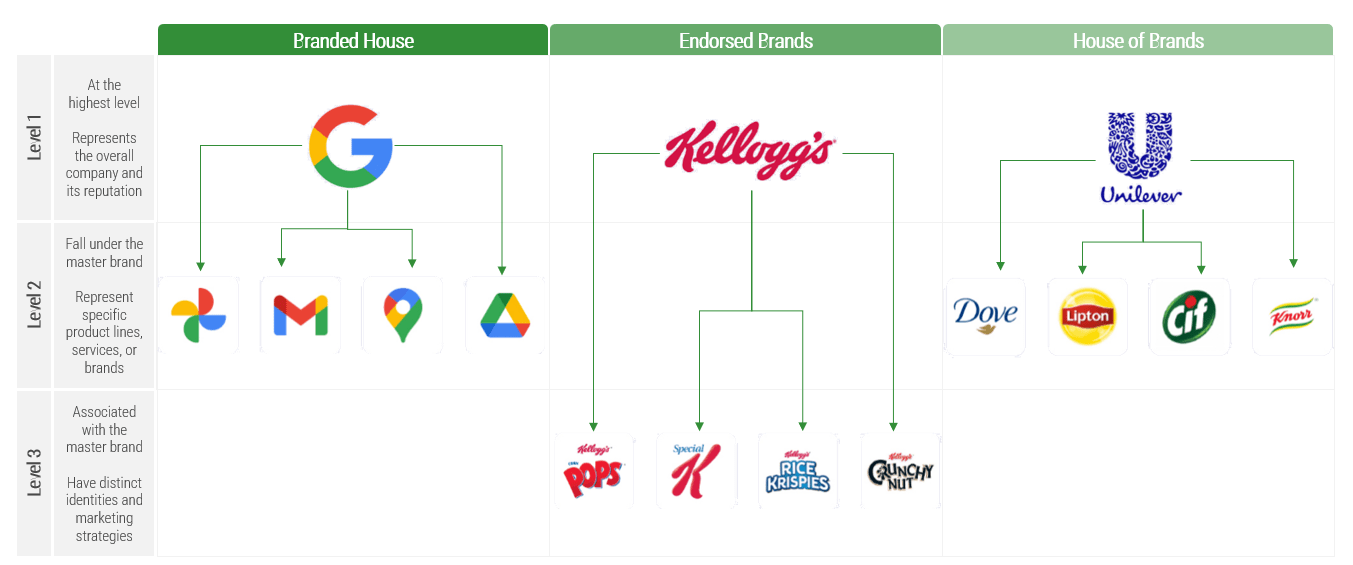
Pros and cons of each architecture types
Different approaches to organizing a brand portfolio
The brand architecture impacts the cohesiveness, effectiveness, and market reach. Defining or redefining organization changes is crucial for company performance.
| Branded House | Endorsed Brands | House of Brands | |
|---|---|---|---|
| Other Designations |
|
|
|
| Description |
|
|
|
| Marketing & Comms |
|
|
|
| Impact on Sales |
|
|
|
| Cost Effectiveness |
|
|
|
| Reputation and Image |
|
|
|
| Consistency |
|
|
|
Brand naming decision tree
Create a naming process for brand alignment and resonance with the target audience
To ensure a chosen name is effective and legally/ethically sound, consider the ease of pronunciation/spelling, the availability for registration of brand/domain name, any negative connotations/associations in any language/culture, and potential legal/ethical issues.
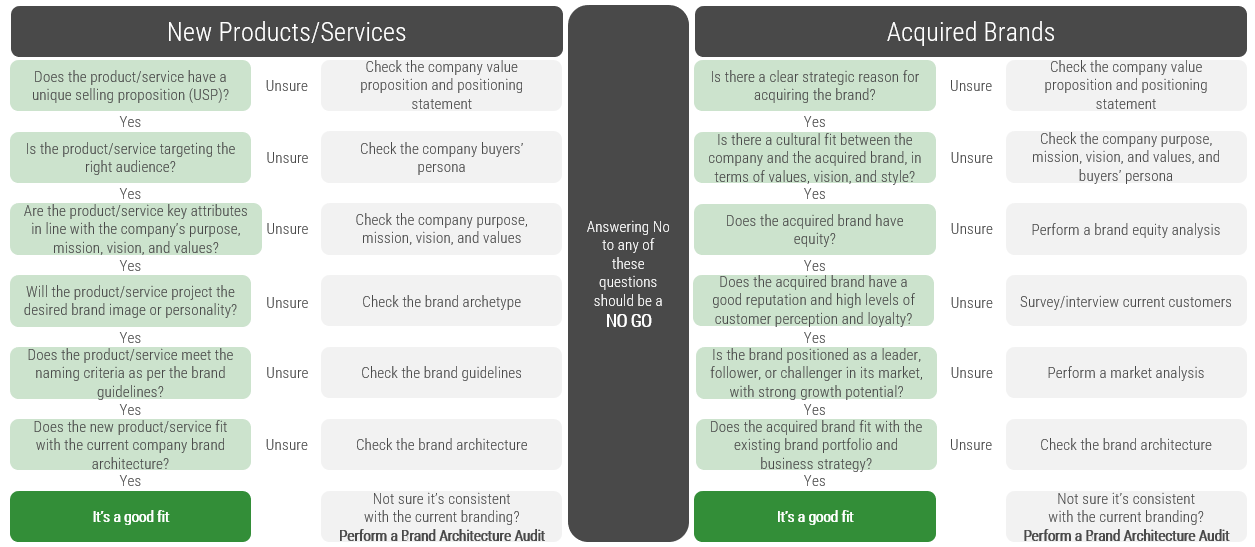
To ensure a chosen name is effective and legally/ethically sound, consider the ease of pronunciation/spelling, the availability for registration of brand/domain name, any negative connotations/associations in any language/culture, and potential legal/ethical issues.
Advantages of defining brand architecture
Maximize your brand potential with a clear architecture strategy.
Clear offering
Adaptability
Consistent branding
Competitive differentiation
Operational efficiency
Strong brand identity
Customer loyalty
Business success
"Responding to external influences, all brands must adapt and change over time. A clear system can aid in managing the process, ensuring that necessary changes are implemented effectively and efficiently."
Source: The Branding Journal
SoftwareReviews' brand architecture creation methodology
| Develop and Implement a Robust Brand Architecture | |
|---|---|
|
Phase Steps |
Step 1 Research and Analysis 1.1 Define brand architecture strategy 1.2 Brand audit 1.3 Identify brand core elements Step 2 Development and Implementation |
| Phase Outcomes |
|
Insight summary
Brand Architecture: Organize and manage your portfolio of brands
Brand architecture is the way a company organizes and manages its portfolio of brands to achieve strategic goals. It encompasses the relationships between brands, from sub-brands to endorsed brands to independent brands, and how they interact with each other and with the master brand. With a clear brand architecture, businesses can optimize their portfolio, enhance their competitive position, and achieve sustainable growth and success in the long run.
Aligning brand architecture to business strategy
Effective brand architecture aligns with the company's business strategy, marketing objectives, and customer needs. It provides clarity and coherence to the brand portfolio, helps customers navigate product offerings, and maximizes overall equity of the brand.
Choosing between three types of brand architecture
A company's choice of brand architecture depends on factors like product range, target markets, and strategic objectives. Each approach, Branded House, Endorsed, or House of Brands, has its own pros and cons, and the proper option relies on the company's goals, resources, and constraints.
A logical brand hierarchy for more clarity
The order of importance of brands in the portfolio, including the relationships between the master and sub-brands, and the positioning of each in the market is fundamental. A clear and logical hierarchy helps customers understand the value proposition of each brand and reduces confusion.
A win-win approach
Clear brand architecture can help customers easily navigate and understand the product offering, reinforce the brand identity and values, and improve customer loyalty and retention. Additionally, it can help companies optimize their marketing strategies, streamline their product development and production processes, and maximize their revenue and profitability.
Brand architecture, an ongoing process
Brand architecture is not a one-time decision but an ongoing process that requires regular review and adjustment. As business conditions change, companies may need to revise their brand portfolio, brand hierarchy, or brand extension and acquisition strategies to remain competitive and meet customer needs.
Brand architecture creation tools
This blueprint comes with tools to help you develop your brand architecture.
Brand Architecture Toolkit
This kit includes a Brand Architecture Mini-Audit, a Brand Architecture template, and templates for Brand Matrix, Ecosystem, and Development Strategy.
Use this kit to develop a strong brand architecture that aligns with your business goals, clarifies your brand portfolio, and enhances overall brand equity.

Brand Architecture
Develop a robust brand architecture that supports your business goals, clarifies your brand portfolio, and enhances your overall brand equity.
"A brand architecture is the logical, strategic, and relational structure for your brands, or put another way, it is the entity's 'family tree' of brands, sub-brands, and named products."
Source: Branding Strategy Insider
Consequences of Neglected Brand Guidelines
When a company neglects its brand architecture and guidelines, it can result in a number of negative consequences, such as:
- Lack of clarity around the brand's personality and values
- Inconsistent messaging and branding
- Inability to differentiate from competitors
- Weak brand identity
- Confusion among customers and employees
- Difficulty launching new products/services or integrating acquired brands
- Lack of recognition and trust from consumers, leading to potential negative impacts on the bottom line.
Benefits of SoftwareReviews' Methodology
By following SoftwareReviews' methodology to develop and maintain a brand architecture, businesses can:
- Establish a unique market position and stand out from competitors
- Ensure that marketing efforts are focused and effective
- Create personalized and engaging customer experiences
- Reinforce messaging and positioning
- Increase customer loyalty and satisfaction
- Build brand recognition and awareness
Marq, formerly Lucidpress, surveyed over 400 brand management experts and found that "if the brand was consistent, revenue would increase by 10-20%."
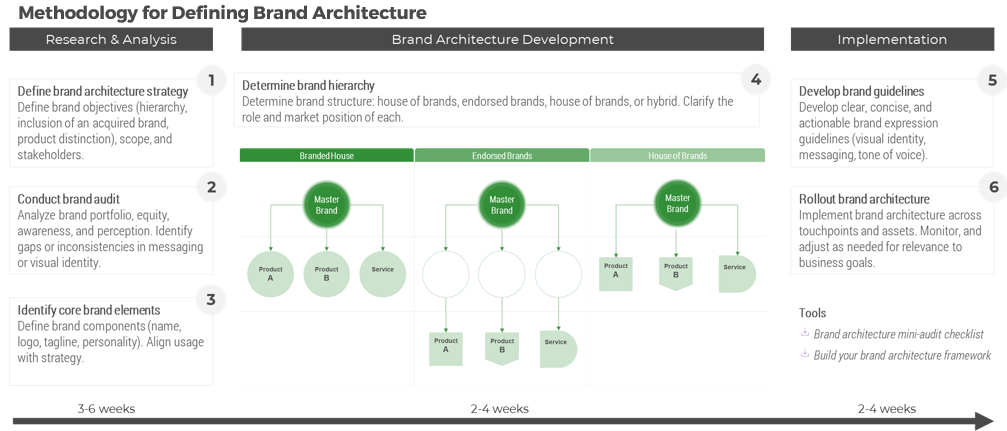
Who benefits from this research?
This research is designed for:
- Organizations that value their brand and want to ensure that it is communicated effectively and consistently across all touchpoints.
- Business owners, marketers, brand managers, creative teams, and anyone involved in the development and implementation of brand strategy.
This research will also assist:
- Sales and customer experience teams
- Channel partners
- Buyers
This research will help you:
- Establish a unique market position and stand out from competitors.
- Create a more personalized and engaging customer experience.
- Ensure that marketing efforts are focused and effective.
- Reinforce brand messaging and positioning.
This research will help them:
- Increase customer loyalty and satisfaction
- Build brand recognition and awareness
- Drive business growth and profitability.
SoftwareReviews offers various levels of support to best suit your needs
| DIY Toolkit "Our team has already made this critical project a priority, and we have the time and capability, but some guidance along the way would be helpful." |
Guided Implementation "Our team knows that we need to fix a process, but we need assistance to determine where to focus. Some check-ins along the way would help keep us on track." |
Workshop "We need to hit the ground running and get this project kicked off immediately. Our team has the ability to take this over once we get a framework and strategy in place." |
Consulting "Our team does not have the time or the knowledge to take this project on. We need assistance through the entirety of this project." |
| Included Within Advisory Membership | Optional Add-Ons | ||
|---|---|---|---|
Guided Implementation
What does a typical GI on this topic look like?
| Research & Analysis | |||
|---|---|---|---|
| Call #1: Discuss brand architecture strategy (define objectives, scope and stakeholders). | Call #3: Identify core brand components and ensure they align with the brand strategy. | Call #5: Develop or update brand guidelines. | Optional Calls:
|
| Call #2: Conduct a brand audit. | Call #4: Define and document the brand hierarchy. | Call #6: Roll out the brand architecture and monitoring. | |
A Guided Implementation (GI) is a series of calls with a SoftwareReviews Marketing Analyst to help implement our best practices in your organization.
Your engagement managers will work with you to schedule analyst calls.
Brand Mind Mapping Workshop Overview
Total duration: 3-4 hours
Activities
Visually map out the different elements of your brand portfolio, including corporate brands, sub-brands, product brands, and their relationships with each other.
The workshop also aims to explore additional elements, such as brand expansions, acquisitions, and extensions, and brand attributes and positioning.
Deliverables
Get a mind map that represents the brand architecture and its various components, which can be used to evaluate and improve the overall coherence and effectiveness of the brand portfolio. The mind map can also provide insights into how different brands fit together and contribute to the overall brand strategy.
Participants
- Business owners
- Head of Branding and anyone involved with the brand strategy
Tools
- Brand Architecture Template, slides 7 and 8
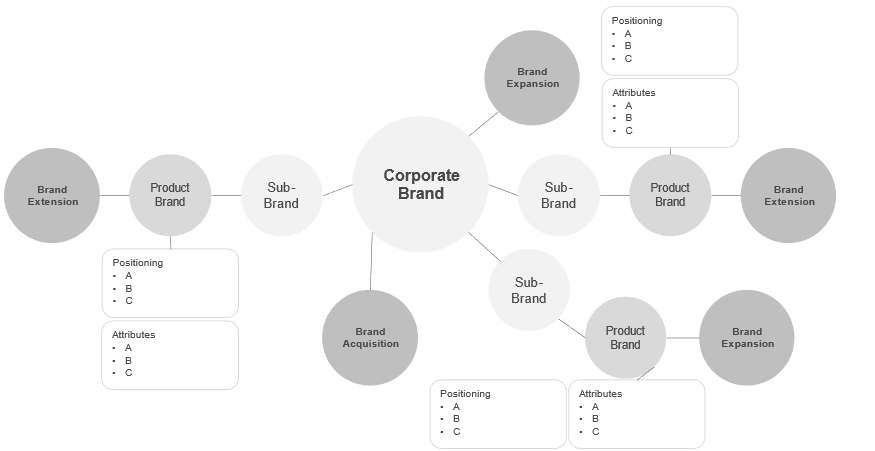
Contact your account representative for more information
workshops@infotech.com | 1-888-670-8889
Get started!
Develop a brand architecture that supports your business goals, clarifies your brand portfolio, and enhances your overall brand equity.
Develop and Implement a Robust Brand Architecture
Step 1 Research and Analysis
1.1 Define architecture strategy
1.2 Perform brand audit
1.3 Identify brand core elements
Step 2 Development and Implementation
2.1 Determine brand hierarchy
2.2 Develop or update brand guidelines
2.3 Roll out brand architecture
Phase Outcome
- Brand current performance is assessed
- Issues are highlighted and can be addressed
- Brand structure is developed and implemented across touchpoints and assets
- Adjustments made on an ongoing basis for consistency and relevance to business goals
Develop and implement a robust brand architecture
Steps 1.1, 1.2 & 1.3 Define architecture strategy, audit brand, and identify core elements.
Total duration: 2.5-4.5 hours
Objective
Define brand objectives (hierarchy, acquired brand inclusion, product distinction), scope, and stakeholders. Analyze the brand portfolio to identify gaps or inconsistencies. Identify brand components (name, logo, tagline, personality) and align them with the brand and business strategy.
Output
By completing these steps, you will assess your current brand portfolio and evaluate its consistency and alignment with the overall brand strategy.
Participants
- Business owners
- Head of Branding and anyone involved with the brand strategy
Tools
- Diagnose Brand Health to Improve Business Growth Blueprint (optional)
- Brand Awareness Strategy Template (optional)
1.1 Define Brand Architecture Strategy
(60-120 min.)
Define
Define brand objectives (hierarchy, inclusion of an acquired brand, product distinction), scope, and stakeholders.
1.2 Conduct Brand Audit
(30-60 min.)
Assess
Assess the state of your brand architecture using the "Brand architecture mini-audit checklist," slide 9 of the Brand Architecture Strategy Template. Check the boxes that correspond to the state of your brand architecture. Those left unchecked represent areas for improvement.
For a more in-depth analysis of your brand performance, follow the instructions and use the tools provided in the Diagnose Brand Health to Improve Business Growth blueprint (optional).
1.3 Identify Core Brand Elements
(60-90 min.)
Identify
Define brand components (name, logo, tagline, personality). Align usage with strategy. You can develop your brand strategy, if not already existing, using the Brand Awareness Strategy Template (optional).
Tip!
Continuously monitor and adjust your brand architecture - it's not static and should evolve over time. You can also adapt your brand strategy as needed to stay relevant and competitive.
Develop and implement a robust brand architecture
Steps 2.1. 2.2 & 2.3 Develop brand hierarchy, guidelines, and rollout architecture.
Total duration: 3.5-5.5 hours
Objective
Define your brand structure and clarify the role and market position of each. Create concise brand expression guidelines, implement them across all touchpoints and assets, and adjust as needed to stay aligned with your business goals.
Output
This exercise will help you establish and apply your brand structure, with a plan for ongoing updates and adjustments to maintain consistency and relevance.
Participants
- Business owners
- Head of Branding and anyone involved with the brand strategy
Tools
- Brand Architecture Template
- Brand Voice Guidelines
- Brand Messaging Template
- Asset Creation and Management List Template
2.1 Determine Brand Hierarchy
(30-60 min.)
Analyze & Document
In the Brand Architecture Strategy Template, complete the brand matrix, ecosystem, development strategy matrix, mind mapping, and architecture, to develop a strong brand architecture that aligns with your business goals and clarifies your brand portfolio and market position.
2.2 Develop/Update Brand Guidelines
(120-180 min.)
Develop/Update
Develop (or update existing) clear, concise, and actionable brand expression guidelines using the Brand Voice Guidelines and Brand Messaging Template.
2.2 Rollout Brand Architecture
Preparation (60-90 min.)
Create & Implement
Use the Asset Creation and Management List Template to implement brand architecture across touchpoints and assets.
Monitor and Adjust
Use slide 8, "Brand Strategy Development Matrix," of the Brand Architecture Strategy Template to identify potential and future brand development strategies to build or enhance your brand based on your current brand positioning and business goals. Monitor, and adjust as needed, for relevance to the brand and business strategy.
Tip!
Make your brand architecture clear and simple for your target audience, employees, and stakeholders. This will avoid confusion and help your audience understand your brand structure.
Prioritizing clarity and simplicity will communicate your brand's value proposition effectively and create a strong brand that resonates with your audience and supports your business goals.
Related SoftwareReviews research
Diagnose Brand Health to Improve Business Growth
Have a significant and well-targeted impact on business success and growth by knowing how your brand performs, identifying areas of improvement, and making data-driven decisions to fix them.
- Increase brand awareness and equity.
- Build trust and improve customer retention and loyalty.
- Achieve higher and faster growth.
Accelerate Business Growth and Valuation by Building Brand Awareness
Successfully build awareness and help the business grow. Stand out from the competition and continue to grow in a sustainable way.
- Get a clear understanding of the buyer's needs and your key differentiator.
- Achieve strategy alignment and readiness.
- Create and manage assets.
Bibliography
"Brand Architecture: Definition, Types, Strategies, and Examples." The Branding Journal, 2022.
"Brand Architecture: What It Is and How to Build Your Brand's Framework." HubSpot, 2021.
"Brand Architecture Framework." Verge Marketing, 2021.
"Brand consistency-the competitive advantage and how to achieve it." Marq/Lucidpress, 2021.
"Building brands for growth: A fresh perspective." McKinsey & Company. Accessed on 31 March 2023.
Daye, Derrick. "Brand Architecture Strategy Guide." Branding Strategy Insider, The Blake Project, 13 May 2021.
Todoran, Adrian. "Choosing the Perfect Brand Architecture Strategy for Your Business." LinkedIn, 2023.